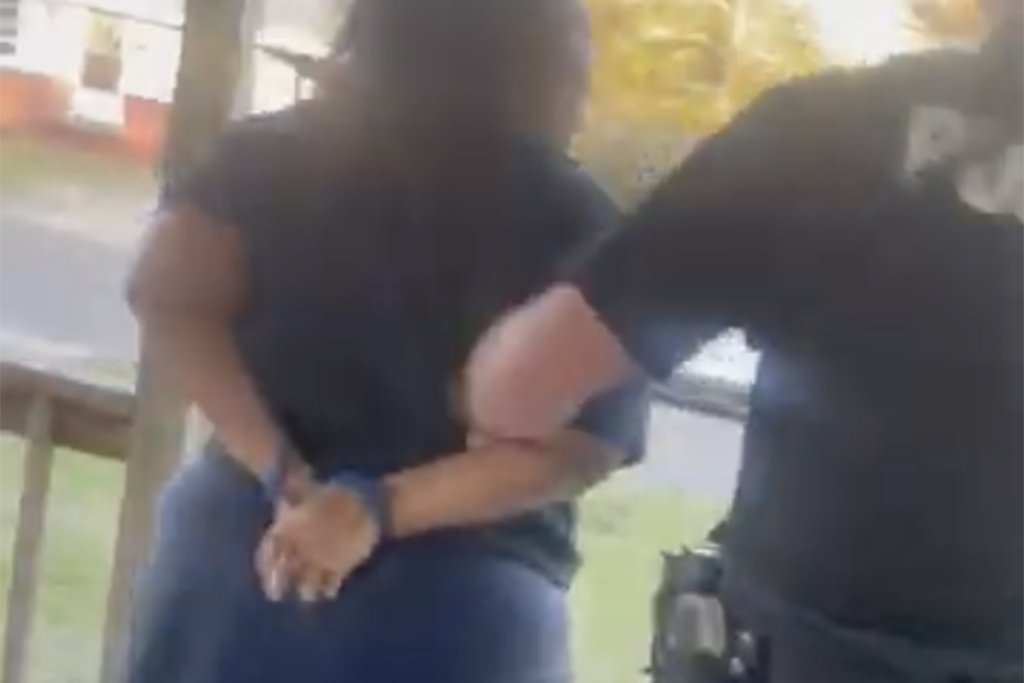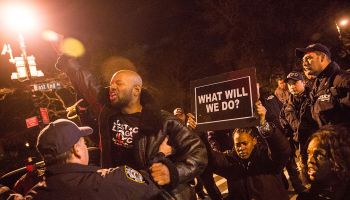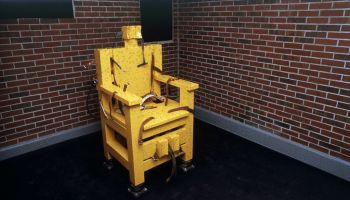UPDATE: Computer Failure May Have Caused D.C. Crash
Investigators looking into the deadly crash of two Metro transit trains focused Tuesday on why a computerized system failed to halt an oncoming train, even though there is evidence that the operator tried to slow it down.
At the time of the crash, the train was also operating in automatic mode, meaning it was controlled primarily by computer. In that mode, the operator’s main job is to open and close the doors and respond to emergencies.
Debbie Hersman, an investigator with the National Transportation Safety Board, said it was unclear if the emergency brake was actually engaged when Monday’s crash occurred. But the mushroom-shaped button that activates it was found pushed down in the operator’s compartment.
Hersman said it wasn’t clear when the button was pressed or how it got that way. She also said there was evidence of braking on the train’s rotors, indicating it was likely that the operator tried to slow down.
The train plowed into a stopped train ahead of it at the height of the Monday evening rush hour, killing nine people and injuring more than 70 in the deadliest accident in the 30-year history of the Metro.
Crews spent Tuesday pulling apart the wreckage and searching for bodies. Authorities also worked to determine why the train’s safeguards apparently did not kick in.
“That train was never supposed to get closer than 1,200 feet, period,” said Jackie Jeter, president of a union that represents Metro workers.
All Metro trains were running on manual control Tuesday as a precaution against computer malfunction.
The cars in the moving train were some of the oldest in the transit network, dating to the founding of the system.
Federal officials had sought to phase out the aging fleet because of safety concerns, but the transit system kept the old trains running, saying it lacked money for new cars.
Hersman told The Associated Press that the NTSB had warned in 2006 that the old fleet should be replaced or retrofitted to make it better able to survive a crash.
Neither was done, she said, which the NTSB considered “unacceptable.”
Metro General Manager John Catoe said the agency expected to receive proposals “over the next month or so” to replace the old cars, but new trains were still years away from being installed. He insisted the existing cars were safe.
This isn’t the first time that Metro’s automated system has been questioned.
In June 2005, Metro had a close call because of signal troubles in a tunnel under the Potomac River. A conductor noticed he was getting too close to the train ahead of him even though the system indicated the track was clear. He hit the emergency brake in time, as did the operator of a train behind him.
Shortly afterward, Metro attributed the problem to a defective communications cable.
The signal relays that control trains were replaced after a serious safety warning in May 2000 by the Federal Railroad Administration. The warning came after failed relays were detected on the system, formally known as the Washington Metropolitan Area Transit Authority.
The operator of the train that barreled into the stopped cars Monday was identified as Jeanice McMillan, 42, of Springfield, Va., according to Metro officials.
McMillan was hired in January 2007 as a bus driver and was tapped to become a train operator in January 2009, the NTSB said. McMillan completed training and began working as an operator in March. Metro officials say employees start out as bus drivers before moving to trains.
Investigators want McMillan’s cell phone and texting records to determine whether she was distracted before the crash, Hersman said.
Safety officials also are investigating a passenger’s statement that the train had stopped briefly then started again before the crash.
Iyesha Thomas, a Metro employee who worked with McMillan, said McMillan would often work the late shift. She did not have a car and if she was unable to get a ride home, she would sleep at Metro’s offices, take thefirst train to Franconia, Va., and return to work later that day.
A neighbor, Aicha Mezlini, said McMillan was killed driving the first train on her 4 p.m.-to-11 p.m. shift. She said McMillan normally worked Tuesday and Wednesday, but last week Metro changed her shift to Monday.
“There is no evidence whatsoever that this driver has done anything to cause this accident,” Catoe said Tuesday.
The crash occurred on the red line near the D.C. and Maryland border, in an area where higher train speeds are common because there is a longer distance between stops. Trains can go 55 to 59 mph, though it was not clear how fast the train that crashed was traveling.
Meanwhile on Tuesday, emergency crews cut away the top of the train that jackknifed on top of a stopped train. They removed the debris with help from a crane brought in overnight.
“The scene that I witnessed was one that no one should have to see,” Catoe said. “It was unbelievable destruction.”
Later, his voice choked with emotion as he addressed hundreds of employees at a prayer vigil Tuesday. He told them the agency will find out what caused the accident and develop a solution.
“We cannot afford to lose any more of our own, or any more of our customers,” Catoe said. “I need your prayers. This agency needs your prayers.”
Metro has long pleaded for more funding to ensure the system’s safety. The transit network is supported by the District of Columbia, Maryland and the Virginia jurisdictions that it serves. However, unlike other major systems, Metro has no dedicated funding source.
Metro officials have long argued that the federal government should contribute because the trains serve the capital, and some 40 percent of rush-hour riders are federal workers.
Catoe said last year it would take $7 billion just to maintain current service and keep the system running safely and reliably from 2010 to 2020. That includes replacements for aging rail cars.
It would take billions more, he said, to deploy longer trains and more buses to meet the projected increase in demand. The number of trips taken on Metro trains is expected to grow 22 percent to about 1 million a day by 2020.
Some passengers involved in Monday’s crash returned to the site Tuesday to get another look at the destruction.
Jamie Jiao, 20, of Vienna, Va., said he was aboard the first car of the moving train just a few feet from where the car was smashed.
“It was only a split second,” he said. “We were probably traveling pretty fast. No one had time to react.”
Jiao had two bandages on his face, and his foot was in a splint. He was walking with a cane and complained of aches in his back. “I’m thankful it isn’t more serious,” he said.
Tijuana Cox, 21, was in the train that was hit. She had her sprained arm in a sling Tuesday.
“Everybody just went forward and came back,” with people’s knees hitting the seats in front of them, said Cox, of Lanham, Md.
The only other fatal crash in the Metro subway system occurred Jan. 13, 1982, when three people died as a result of a derailment. That was a day of disaster in the capital: Shortly before the subway crash, an Air Florida plane slammed into the 14th Street Bridge immediately after takeoff from Washington National Airport. The plane crash, during a severe snowstorm, killed 78 people.
In January 2007, a subway train derailed in downtown Washington, sending 20 people to the hospital and requiring the rescue of 60 others from the tunnel.
In November 2006, two Metro track workers were struck and killed by an out-of-service train. An investigation found that the train operator failed to follow safety procedures. Another Metro worker was struck and killed in May 2006.
At Least 6 Dead In D.C. Train Crash, June 23, 2009
One Metro transit train smashed into the rear of another at the height of the capital city’s Monday evening rush hour, killing at least six people and injuring scores of others as the front end of the trailing train jackknifed violently into the air and fell atop the first.
Cars of both trains were ripped open and smashed together in the worst accident in the Metrorail system’s 33-year history. District of Columbia fire spokesman Alan Etter said crews had to cut some people out of what he described as a “mass casualty event.” Rescue workers propped steel ladders up to the upper train cars to help survivors scramble to safety. Seats from the smashed cars spilled out onto the track.
D.C. Mayor Adrian Fenty said six were confirmed dead. Fire Chief Dennis Rubin said rescue workers treated 76 people at the scene and sent some of them to local hospitals, six with critical injuries. A search for further victims continued into the night.
A Metro official said the dead included the operator of the trailing train. Her name was not immediately released.
The crash around 5 p.m. EDT took place on the system’s red line, Metro’s busiest, which runs below ground for much of its length but is at ground level at the accident site near the Maryland border in northeast Washington.
Metro chief John Catoe said the first train was stopped on the tracks, waiting for another to clear the station ahead, when the trailing train, one of the oldest in the Metro fleet, plowed into it from behind.
Officials had no explanation for the accident. The National Transportation Safety Board took charge of the investigation and sent a team to the site. DC police and the FBI also had investigators at the scene to help search the wreckage for any overlooked injured or dead passengers and evidence.
Officials would not say how fast the train was traveling at the time of the accident. The crash occurred in an area with a sizable distance between rail stations in which trains are allowed to travel at higher speeds, Metro spokeswoman Candace Smith said.
The trains’ devices that record operating speeds and commands are being turned over to the NTSB, Smith said.
Each train had six cars and was capable of holding as many as 1,200 people. Safety Board member Debbie Hersman said the trains were bound for downtown. That would mean they were less likely to be filled during the afternoon rush hour.
The trains had pulled out of the Takoma Park station and were headed in the direction of the Fort Totten station.
More than 200 firefighters from D.C., Maryland and Virginia eventually converged on the scene. Sabrina Webber, a 45-year-old real estate agent who lives in the neighborhood, said the first rescuers to arrive had to use the “jaws of life” to pry open a wire fence along rail line to get to the train.
Webber raced to the scene after hearing a loud boom like a “thunder crash” and then sirens. She said there was no panic among the survivors.
Passenger Jodie Wickett, a nurse, told CNN she was seated on one train, sending text messages on her phone, when she felt the impact. She said she sent a message to someone that it felt like the train had hit a bump.
“From that point on, it happened so fast, I flew out of the seat and hit my head.” Wickett said she stayed at the scene and tried to help. She said “people are just in very bad shape.”
“The people that were hurt, the ones that could speak, were calling back as we called out to them,” she said. “Lots of people were upset and crying, but there were no screams.”
One man said he was riding a bicycle across a bridge over the Metro tracks when the sound of the crash got his attention.
“I didn’t see any panic,” Barry Student said. “The whole situation was so surreal.”
At Howard University Hospital, Dr. Johnnie Ford, an emergency room doctor, said a 14-year-old girl suffered two broken legs in the accident. A 20-year-old male patient “looked like he had been tumbled around quite a bit, bumps and bruises from head to toe,” Ford said.
Homeland Security Department spokeswoman Amy Kudwa said less than two hours after the crash that federal authorities had no indication of any terrorism connection.
“I don’t know the reason for this accident,” Metro’s Catoe said. “I would still say the system is safe, but we’ve had an incident.”
Monday’s crash was the third major subway or commuter rail crash in a big city in the past nine months. In the earlier accidents:
• In September 2008, a commuter rail train and a freight train crashed in Los Angeles, killing 25 people. The crash was blamed on an engineer on the commuter rail sending text messages on a cell phone.
• Last month about 50 people were injured in Boston when one trolley rear-ended another. The conductor admitted to sending a text message when the crash occurred.
No reason was given for the Washington crash, but some safety experts are concerned about the recent increase.
“I’m not sure if everyone in the safety system is paying the proper attention that needs to be paid,” said Barry Sweedler, a San Francisco-based safety consultant and former investigator and manager at the NTSB. “These things shouldn’t be happening.”
However, Robert Lauby, a former NTSB rail investigator, said the increase in accidents could well be mere coincidence.
“Just because you had them doesn’t mean there’s a specific issue that caused them,” Lauby said.
The only other time in Metrorail’s 33-year history that there were passenger fatalities was on Jan. 13, 1982, when three people died as a result of a derailment underneath downtown. That was a day of disaster in the capital — shortly before the subway crash, an Air Florida plane slammed into the 14th Street Bridgeimmediately after takeoff in a severe snowstorm from Washington National Airport across the Potomac River. The plane crash killed 78 people.
From CNN.com:
Two Metro subway trains collided between stations north of downtown Washington, D.C., during afternoon rush hour Monday, killing at least one person, CNN has confirmed.
The crash occurred just before 5 p.m. on an above-ground track on the Red Line in Takoma Park, Maryland, just north of the District of Columbia.
















